Soviet RPG-2 launcher with strap, covers and grenade in firing position. This specimen dates to 1952. Photo Courtesy LMO, LLC Reference Collection.
By Paul Newhouse
Since the start of Operation Iraqi Freedom, most everyone have heard or seen news reports about the employment of RPGs by anti-Coalition forces; or what are referred to as “Rocket Propelled Grenades” by the news media. While the weapon shown is almost invariably the RPG-7, with perhaps an odd RPG-2 thrown in, there’s a lot more to the RPG story than those one or two familiar systems.
Perhaps we should start with a bit of etymology. While “RPG” has had three different meanings in the past 65 years, the acronym has never stood for “rocket propelled grenade.” Indeed, all the early RPGs had no rockets of any kind incorporated into their design, and the ubiquitous RPG-7 fires grenades both with and without rocket assist.
The first RPGs were simply shaped charge hand grenades. “RPG” in their case stood for Ruchnaya Protivotankovaya Granata – Hand Antitank Grenade. (The author wishes to apologize in advance for any improper transliterations of Russian, though his spellings are more or less phonetically correct.) The two best known examples were the RPG-43 and RPG-6. While resembling stick grenades or “potato mashers” with large heads, their method of operation was rather more complex. Upon pulling a safety pin and throwing, a safety lever on the handle separated, allowing a stabilizing drogue chute to deploy, ensuring that the grenade impacted top down. A later version produced by the Russians was designated RKG-3, with the “K” standing for Kumulativnaya – shaped charge – to preclude confusion with the later kinds of RPGs. This design was copied by Yugoslavia as the M79. These grenades remain effective against all but the most modern armored vehicles. In fact, the US Army in the 1980s reverse-engineered an East German design. Their fatal flaw is their short effective range, approximately 30 meters.

The first of the weapon systems to resemble today’s RPGs was the RPG-1, development of which started at the end of World War 2. In this case, “RPG” stands for Ruchnoi Protivotankoviyi Granatomyot – Hand Antitank Grenade Launcher. Despite Russian protestations that it was developed independently, the RPG-1 clearly owes much to both the German Panzerschreck rocket launcher (for the design of the warhead) and the Panzerfaust recoilless launcher; particularly the late-war reusable versions. The RPG-1 utilized the Panzerfaust’s simple launch tube, and as a result had to employ a black powder propelling charge that produced a very low muzzle velocity. The RPG-1 was not produced in large numbers.
The first widely produced RPG was the RPG-2, introduced in the late 1940s or early 1950s, coincidentally at the same time the AK-47 was beginning to enter service. This again utilized the Panzerfaust-type straight tube recoilless launch system, but now the PG-2 (Protivotankovaya Granata – Antitank Grenade) grenade bore a very obvious resemblance to that of the Panzerfaust 150, with a conical nose, cylindrical mid-body, and tail boom with wraparound fins. As the RPG-2 was thoroughly described in a previous issue of SAR (Vol. 10, No. 3), no further description is offered here.
Both the RPG-1 and RPG-2 were tactically comparable to the US “Bazooka” and British PIAT, being different systems capable of operation by a single man, but normally served by a two man crew. At about the same time as the RPG-2 was introduced, a heavier anti-armor weapon system also came into service. This was the 82mm SPG-82 (“SPG” stood for Stankovoi Protivotankoviyi Granatomyot – Mounted Antitank Grenade Launcher), development of which also began late in World War 2. Unlike the RPG-1 or RPG-2, this was a rocket system comparable to the US M20 3.5in “Super Bazooka.” Despite the smaller caliber, the SPG-82 was heavier and longer than the M20, with a large shield with wheels provided for the two man crew. The SPG-82 may be considered almost a general purpose infantry support weapon, akin to the early US recoilless rifles, as it had both PG-82 antitank grenades and OG-82 (Oskolochnaya Granata) fragmentation grenades. Both of these “grenades” were of course rockets.
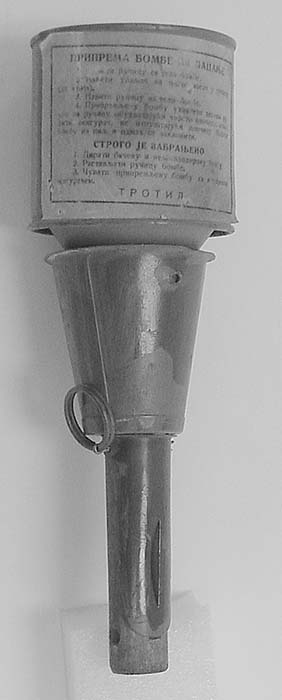
Russian RPG-43 hand-thrown shaped charge antitank grenade. 
Russian RKG-3 hand-thrown shaped charge antitank grenade.
At this point it may be wise to digress a moment and differentiate between infantry antitank weapon systems that are rockets, and those that are recoilless guns. Most frequently the majority of such weapons are described as rocket launchers, but this is glaringly inaccurate. The well-known M136/AT4 single-shot weapon in widespread use by the US Army is in fact a disposable recoilless launcher. The infamous RPG-7, despite firing rocket-assisted projectiles, is a reusable recoilless launcher.
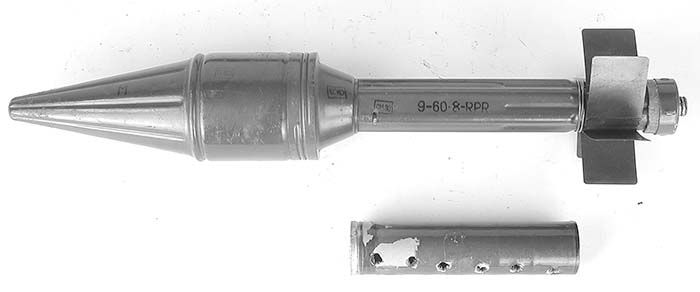

One supposes the key distinguishing feature is where the pressure, built up by propellant combustion, occurs, and where the pressure drop which produces the propulsive force occurs. In a rocket system, the propellant combusts entirely within the rocket itself, and the pressure drop which produces the propulsive force occurs across the body of the munition. This may best be illustrated by considering the case of a rocket like that from an M72 LAW being ignited outside its launch tube. The rocket would travel just as far as if it were fired normally; the tube only provides for initial aiming, and does not contribute to the propulsive process.

In a recoilless weapon, the launch tube is an integral part of the propulsive process, and incorporates a chamber for the propellant to burn at a relatively high pressure, and a nozzle to create a constriction that vents the high pressure gases rearwards, usually at an accelerated velocity, whose momentum is then used to balance exactly the momentum of the projectile leaving the muzzle. If one were to ignite the propelling charge of a PG-2 or a PG-7 in the open, it would simply burn. The grenade would not go anywhere. Without a chamber to allow burning at a high pressure, no propulsive force is generated.
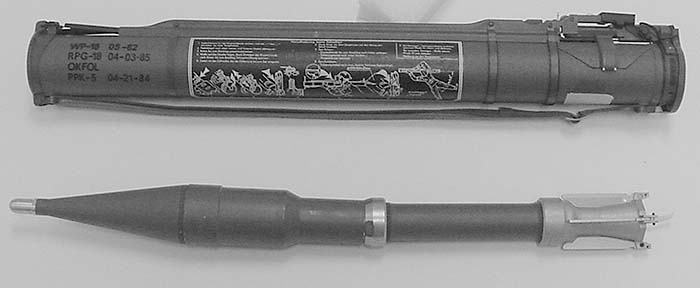
It’s also worthwhile to take a brief look at the physics of recoilless weapons. Simply put, recoilless guns work by expelling a projectile from the front in the usual manner, and a countermass out the back of the gun. The earliest recoilless guns were the Davis Guns of WW1. These used a central propelling charge to fire a projectile out of a forward-pointing barrel, and a solid countermass of equal weight out a rearward pointing barrel of identical length. While solid countermass recoilless guns have been in use since then, and a few still are, in most applications a solid countermass is a nuisance at best and a danger to one’s own troops at worst. Between the wars it was found that it was only necessary to match the momentum (mass times velocity) of the countermass to that of the projectile. Thus, a very light countermass, such as propellant gas moving at a very high velocity, can have a momentum equal to a heavy projectile discharged at a lower velocity.

Most recoilless guns using a propellant gas countermass feature a prominent nozzle or nozzles at the back of the weapon. These are sometimes called venturis (acceptable) or “blast cones” (incorrect); more on these below. But one can’t help but note that the Panzerfausts and the RPG-2 had simple straight-tube launchers with neither constricting orifices nor conical venturis. So how did these weapons function, without simply venting the propellant gases out the back at low pressure? The answer lies in the fluid mechanics of compressible fluids. Most of us are aware that passing a fluid through a constriction will raise the velocity of the fluid. (Simply take your garden hose and constrict the water stream with your thumb, and watch how the water speeds up.) The higher the upstream pressure the greater the downstream velocity. But in gas systems, this only happens until a condition called choked flow is reached. At that point further increases in upstream pressure do not cause further increases in downstream velocity. The result in a recoilless weapon is a rise in pressure sufficient to launch a projectile. While this principle is the basis for most recoilless weapons, in straight tube launchers it has substantial performance limitations.
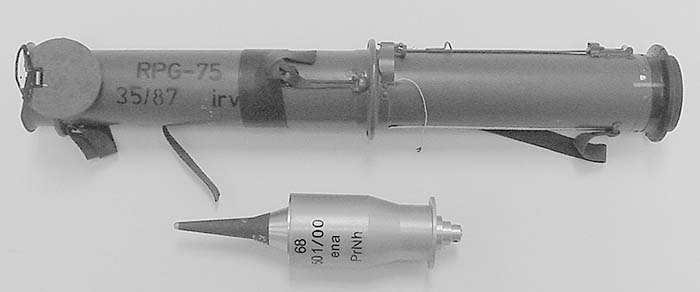
The outlet velocity of the propellant gases in a straight tube launcher remains subsonic. And to achieve a choked flow situation quickly, very fast burning propellant is required; in the RPG-2 fine granular black powder is used. But this fast propellant in turn causes a rapid pressure rise in the area of the propelling charge. The maximum pressure must be limited to remain within the strength limits of the tube. So there’s a limit to the weight of propellant that can be used, which in turn limits the mass of propellant gas available to form a countermass. As already mentioned, the gas velocity is limited in this system as well, the result is a relatively low available counterrecoil momentum. The final result of all these limiting factors is a very low muzzle velocity for a projectile of useful size. This was readily apparent in the early Panzerfausts, whose effective range was severely limited, at first to only 30 meters, by their low velocity and resultant highly curved trajectory.

Since gas velocity and tube strength impose limits on available counterrecoil momentum, the only way to really improve this system’s performance was to add additional propellant (and thus additional gas for the countermass), and since increasing the charge attached to the projectile would only increase the local pressure to unacceptable levels, the only solution available was to apply the maximum operating pressure over a greater length of the launch tube by distributing the propelling charge. In the later, longer-range Panzerfausts this was achieved by adding a secondary propelling charge approximately in the middle of the launch tube. The charge at the base of the projectile was initiated in the usual way, and this in turn ignited the secondary charge, boosting muzzle velocity and thus range, up to 100 meters and more.
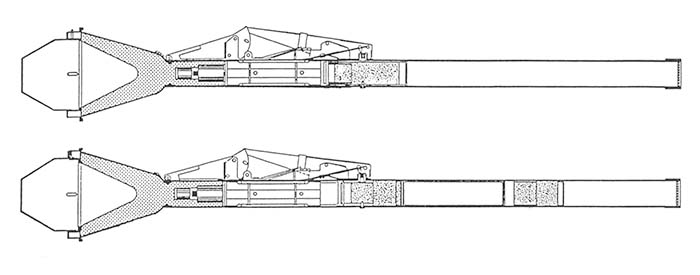

The RPG-2 uses a rather more ingenious solution, with the black powder propelling charge subdivided into 6 increments by means of cardboard tubes and discs, the latter with flash holes to foster ignition. The primer in the base of the PG-2 grenade ignited the first increment, which burns rapidly, creating pressure and pushing the remaining four increments back down the tube. After a few inches of travel, the second increment is fully ignited, then the third, fourth, fifth, and sixth. The result is high pressure over a greater length of the tube, rather than merely at the base of the projectile, and a greater volume of propellant gases for both propulsion and countermass.
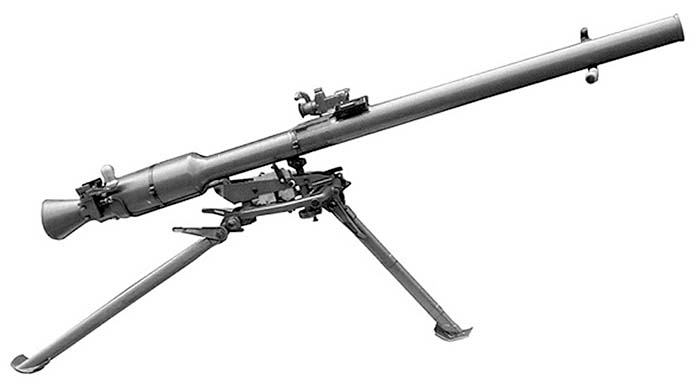
But even with this technique, there were limits to the performance of a simple straight tube launcher. One attempt at improvement was the Yugoslav M57 launcher, which incorporated a partial solid countermass in the form of a quantity of sand. However, this represented at best an incremental improvement over the simple straight tube launchers.

But back to the RPG story! While the PG-2 grenade performed well enough in terms of armor penetration (and remains a threat to all but the most modern armored fighting vehicles), the weapon’s fatal flaw was its very primitive recoilless launcher. While its simple cylindrical tube was easy and cheap to fabricate, its lack of a chamber and nozzle, and resultant low pressure combustion, as described above, severely limited the velocity of the PG-2. This made range estimation very important at all but the shortest ranges. Additionally, the low velocity meant a longer time of flight. Both factors limited hit probability against both stationary and moving targets. An interim solution was found in the RPG-4. While this fired purely ballistic grenades, which resembled PG-2s albeit with increased standoff for the shaped charge, the 45mm diameter launch tube incorporated a larger diameter chamber and a venturi, or nozzle, at its rear end, causing it to greatly resemble its successor the RPG-7. The RPG-4, developed in the late 1950s, was not produced in quantity.

A brief description of the physics of the RPG-4 and RPG-7 is in order. These weapons incorporate the features seen in other, larger recoilless systems: a chamber of larger size than the propelling charge, and a convergent-divergent nozzle incorporating a constriction and a divergent (outlet diameter larger than inlet diameter) conical section. The constriction sets up the choked flow condition described above, albeit without the need to use a very fast propellant. The conical divergent nozzle in turn accelerates the propellant gases to supersonic speeds. Thus, in this type of system, there is much more counterrecoil momentum produced, both from burning more propellant over a longer time and from expelling the gas countermass at a much higher velocity. In the case of the RPG-7, this allowed the launching of projectiles heavier than PG-2s at velocities in some cases approaching double those of the older system.
The RPG-7 recoilless launcher, introduced in 1961, reverted to the 40mm tube diameter of the RPG-2 while retaining the chamber and nozzle design of its precursor the RPG-4. As the RPG-7 and its ammunition have already received a thorough treatment in the pages of SAR (Vol. 10, No. 3), no further description of the system will be given here. A brief observation on the function of its ammunition will be made in the hope of finally putting to rest the absurd “rocket propelled grenade” name. The RPG-7’s principal munition is one of a series of PG-7 antitank grenades. All of these incorporate a rocket motor. As the RPG-7 is a recoilless launcher, the PG-7 may be considered a rocket-assisted projectile; calling it a rocket would be incorrect. The reason for adoption of a recoilless-launched, rocket-assisted antitank munition of greater-than-average complexity is simple: it increases the munition’s velocity and thus reduces its trajectory and time of flight, without imposing any additional penalties on either the launcher or its user. The result is greatly improved hit probability against both moving and stationary targets. In a 1970s study the US Army deemed the RPG-7 the best solution to hitting armored vehicles out to 300m. Better than pure rocket systems and better than pure recoilless systems. But what would happen if the rocket motor in a typical PG-7 failed to ignite 10-15 meters from the launcher like it’s supposed to? All that would happen is that the grenade would follow a purely ballistic trajectory to the target, take longer to get there, and impact below the desired aimpoint. The shaped charge in its warhead would function just as well as if the rocket motor had fired, since the VP-7 fuze is independent of the rocket motor.

Another heavier system was introduced just after the RPG-7, the 73mm SPG-9 smoothbore recoilless gun. Though it filled a similar tactical role as the earlier 82mm B-10 and 107mm B-11 recoilless guns, it is a significantly lighter and handier weapon, which may explain its “SPG” nomenclature. Like the SPG-82, the SPG-9 fires two natures of ammunition: the PG-9 antitank grenade (which is rocket assisted for the same reasons the PG-7 is), and the OG-9 fragmentation grenade (which is an unassisted, purely ballistic munition).


A less-well-known weapon system, whose intended employment is also not as well known, is the RPG-16. Although its nomenclature may lead one to believe it was a replacement for the RPG-7, it really isn’t. The RPG-16 has a bore size of 58mm, and as it does not use an overcaliber warhead, its antiarmor performance is significantly less than more modern versions of the PG-7. At the same time the RPG-16 is significantly heavier than the RPG-7. So rather than looking at the RPG-16 as a successor to the RPG-7, it may be more appropriate to consider it as a subcompact derivative of the SPG-9, for use in those situations where the larger and heavier SPG-9 may be unsuitable. One Russian source mentions that the RPG-16 was developed primarily for airborne troops; its two piece takedown design, similar to that of the RPG-7D, seems to bear this out.
The third meaning of “RPG” is Reaktivnaya Protivotankovaya Granata, applied to a number of disposable pure rocket systems similar to, and likely inspired by, the US M72 LAW. “Reaktivnaya” is awkward to translate; some sources say jet, others rocket, and others “propulsive.” (Perhaps the best way to think of it is as “reactive propulsion,” in other words, a rocket). Also note that the whole system together is not a Granatomyot (grenade launcher), but a Granata (grenade).
The earliest such Russian system was the 64mm RPG-15, which was produced in only limited numbers. This was followed by the very widely produced 64mm RPG-18, also previously covered in the pages of SAR. The RPG-18 was augmented, but not really supplanted, by the 72.5mm RPG-22. Both of these systems employ rocket motors and folding fins inspired by the M72 coupled to warheads essentially identical to those used in PG-7s.
There are newer RPGs which have been designed and produced by the Russians: the RPG-26, 27, 28, and 29. The first three are single-shot weapons, while the last is a long and somewhat unwieldy reusable launcher. All feature larger diameters for improved armor penetration, and some feature tandem warheads for improved effectiveness against reactive armor. But as these systems have not been produced or fielded in large numbers, they will not be considered further.
Finally, there are two additional systems called “RPGs,” produced in Warsaw Pact countries, which have nothing in common with any of the RPGs previously mentioned, but which are so novel that they must be mentioned, if only in passing. While the grenade of the single-shot Polish RPG-76 Komar (Mosquito) resembles a small PG-7, in fact the RPG-76 is a pure rocket system; the rocket motor ignites upon firing, and its PG-7-like nozzles direct the exhaust gases away from the firer. Even so, it must be quite disconcerting to fire this weapon. The launcher is simplicity itself, consisting of a short tube with a folding shoulder stock and crude sights and trigger mechanism.
The single-shot Czech RPG-75 is as finely finished as the Polish weapon is crude. While its light launch tube may lead one to believe that it’s a rocket system, in fact it’s a smoothbore recoilless high-low pressure launcher, the only such weapon ever fielded, successfully combining the two novel gun propulsion technologies pioneered by the Germans and others in WW2. Because the RPG-75 has a separate high pressure chamber, the launch tube does not need to be as heavy as in a conventional recoilless launcher. Finally, the RPG-75’s projectile is neither fin nor spin stabilized, but uses a rear spoiler for stabilization. The only other application of this stabilization technique the author is aware of is in the 120mm M831A1 practice cartridge fired by the M1A1/A2 Abrams tank.

Now that you know the history of the RPG family of weapons and munitions, try not to cringe as the author does upon hearing or seeing the term “rocket propelled grenade!”
| This article first appeared in Small Arms Review V11N1 (October 2007) |










